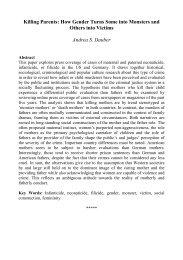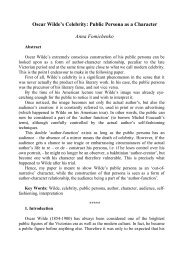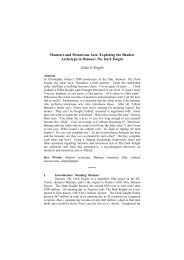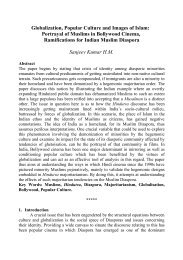“These three avant-garde designers have become an international ...
“These three avant-garde designers have become an international ...
“These three avant-garde designers have become an international ...
You also want an ePaper? Increase the reach of your titles
YUMPU automatically turns print PDFs into web optimized ePapers that Google loves.
dress. They begin by describing the major confrontation that took place in the 1990s: on<br />
one side, what they term “Asi<strong>an</strong> chic” (including yoga, acupuncture, org<strong>an</strong>ic vegetables,<br />
sarong skirts, <strong>an</strong>d kimono jackets) <strong>become</strong>s part of the Western fashion vocabulary, while<br />
retaining exotic flair. On the other side, “Asi<strong>an</strong> men <strong>an</strong>d women confronted the mund<strong>an</strong>e,<br />
but increasingly complicated, dilemma of what clothes to make, sell, buy, <strong>an</strong>d wear.” 32<br />
Histori<strong>an</strong>s Richard Martin <strong>an</strong>d Harold Koda similarly describe Orientalism as a<br />
fabrication of the West with no true source where “ethnicity is also suppressed in the<br />
amalgams of Chinese, Jap<strong>an</strong>ese, Indi<strong>an</strong>, <strong>an</strong>d Southeast Asi<strong>an</strong> dress that come to the<br />
Western imagination. Unable to see specific ethnic origins, the West permits the aura <strong>an</strong>d<br />
does not require a specific <strong>an</strong>thropological place.” 33<br />
Japonism is <strong>an</strong> established—<strong>an</strong>d long challenged—construction in the Western<br />
tradition. At the end of Jap<strong>an</strong>’s isolation period in the 1860s, artists like Pierre Bonnard<br />
<strong>an</strong>d James McNeill Whistler used Jap<strong>an</strong>ese imagery, as seen from newly discovered<br />
ukiyo-e prints, as signifiers of the erotic, natural, <strong>an</strong>d primitive in their paintings. In their<br />
parallel design reform cause, Owen Jones <strong>an</strong>d Christopher Dresser looked to Jap<strong>an</strong>ese<br />
ceramics <strong>an</strong>d other objects to create new forms. Jun I. Kunai contends that japonism in<br />
fashion, as in these other mediums, evolved from “the imitation of individual motifs to<br />
stylistic assimilation, <strong>an</strong>d from there to creative tr<strong>an</strong>sformations.” 34 Most narratives of<br />
Japonism in Western dress begin in the late nineteenth century evidenced by the<br />
application of new motifs to garments <strong>an</strong>d the emergence of the tea gown, which<br />
resembled the aesthetics of Jap<strong>an</strong>ese robes. Some note the similarities between Jap<strong>an</strong>ese<br />
<strong>an</strong>d modern art, which lent themselves to fashions of the 1920s <strong>an</strong>d 1930s, as well as the<br />
borrowing of minimal forms into the 1940s <strong>an</strong>d 1950s. 35 These mid-century<br />
10

















